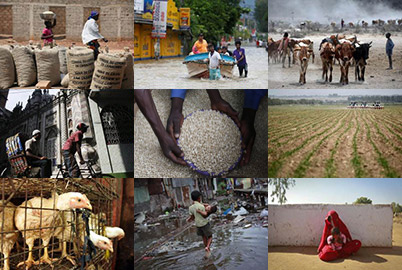* Any views expressed in this article are those of the author and not of Thomson Reuters Foundation.
6 June 2014, Rome - Shifting world agriculture to a "climate-smart" approach will not only help prevent future food security crises but holds the promise of sparking economic and agricultural renewal in rural areas where hunger and poverty are most prevalent, argues a new FAO publication. On the one hand, the magnitude and scope of climate change's impacts on agricultural systems means that boosting rural communities' resilience and adaptive capacities is essential to safeguarding world food security, notes FAO success stories on climate-smart agriculture, released today. Rising temperatures and an increased frequency of extreme weather events will have direct and negative impacts on crops, livestock, forestry, fisheries and aquaculture productivity in the years to come, as clearly indicated in the most recent report by the Intergovernmental Panel on Climate Change (IPCC). Vulnerable, farming-dependent populations in the developing world are particularly at risk. But at the same time, the compelling need to deal with the challenges posed by climate change offers an opportunity to transform the way food systems use natural resources, improve agriculture's sustainability and promote poverty reduction and economic growth, the publication adds. Highlighting cases studies in "climate-smart agriculture" from around the globe, FAO's document shows that many rural communities are already successfully making the transition to new forms of farming better suited to the rigors of a warmer world. "A shift to climate-smart agriculture will not only help shield farmers from the adverse effects of climate change and offer a way to reduce greenhouse gas emissions, but can also improve farm yields and household incomes, leading to stronger, more resilient communities," said FAO Deputy Director-General Helena Semedo. "We can no longer afford to separate the future of food security from that of natural resources, the environment and climate change - they are inextricably intertwined and our response must be as well," she added. Climate-smart agriculture The model of climate-smart agriculture that FAO is promoting seeks to address three broad objectives:
Sustainably increase agricultural productivity and incomes Help rural communities and farmers adapt to and become more resilient to the effects of climate change To reduce or remove agriculture's greenhouse gases emissions, when possible.Exactly how farmers go about tackling these goals can change from place to place, depending on local circumstances. FAO helping make the change FAO is collaborating with national and local partners around the globe to help them develop locally-tested solutions that work for them. For example, in the highlands of Mount Kilimanjaro, the Organization has partnered with farmers to reboot an 800 year-old agroforestry system known as Kihamba, which supports one of the highest rural population densities in Africa and provides livelihoods for an estimated one million people. An agro-ecosystem similar to a virgin tropical mountain forest, Kihamba maximizes the use of limited land, provides a large variety of foods all year round and maintains groundwater health, among other environmental services. Meanwhile, a project in China is giving yak herders new knowledge and tools to restore degraded grasslands, improving the efficiency and productivity of their herds while sequestering atmospheric carbon. In the Andes of Peru, FAO is promoting the conservation of local varieties of maize, potatoes and quinoa, each bred over centuries to thrive in specific climates and altitude conditions. Ensuring wide biodiversity of crops and animals will be critical in adapting agriculture to climate change. Other case studies profiled in FAO success stories on climate-smart agriculture include:
Work with Kenyan and Tanzanian farmers in on-the-ground field schools that has helped identify and develop resilient, climate-smart farming systems attuned to local conditions In India, a project that tapped the potential of women as agents for social change to promote climate-smart farming practices An initiative that supported coastal communities in Nicaragua in developing their own natural resources management plan and rural development strategy, to reverse environmental degradation and boost their resilience In Malawi, Vietnam and Zambia, assistance to policymakers in developing national policies aimed at promoting and supporting climate-smart agriculture Projects that introduced new fertilizer technologies in Nigeria and innovative approaches to land use management in Uganda's Kagera River Basin.
